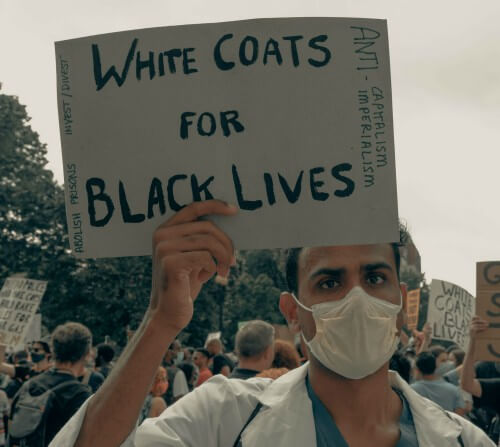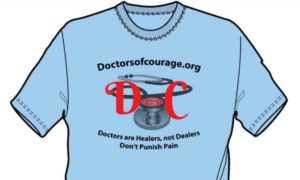On November 6, 2020, an article by Malini Ghoshal, Hanna Shapiro, Knox Todd, and Michael E. Schatman was published in the Journal of Pain Research. In the article, they point out the blatant discrimination against Blacks, Indians, and People of Color (BIPOC) who seek treatment for pain.
Some of the statistics show the following discriminatory actions in the medical offices:
- Black patients receiving opioid analgesia were found to be more likely to be subjected to urine drug testing.
- Black patients receiving opioid analgesia were more restricted with early refills than White patients.
- Black chronic pain patients were determined to be more likely to have their long-term opioid therapy discontinued following the detection of illicit drug use than were White patients.
- Black patients are more likely to have their dosages reduced than are White patients.
These findings are particularly discouraging in light of recent data indicating that
- Prescription pain medication misuse is less common among Black patients than in any other racial and ethnic group studied.
- A 2018 study found that prescription opioid abuse was significantly lower among Black and Latinx patients admitted for opioid misuse treatment as compared to admitted White patients.
- Deaths from prescription opioids are more common among White individuals misusing than BIPOC misusers.
- A 2020 study determined that while BIPOC chronic pain patients were less likely than White patients to receive a prescription for opioids, they were more likely to receive a prescription for naloxone, signaling providers’ heightened mistrust of BIPOC patients’ personal medication management.
These findings are consistent with the “racialization” of legitimate opioid use vs prescription and illicit opioid misuse that has been described in the literature. Collectively, these studies paint a clear picture of BIPOC patients being perceived as less “worthy” of opioid analgesia, at higher risk of aberrancy, and requiring more rigorous risk mitigation – irrespective of the data demonstrating that this represents an egregious false narrative
As a result of this discrimination, data suggests that many BIPOC individuals go so far as to delay, avoid seeking, or prematurely discontinue health care. Again, BIPOC patients’ access to adequate medical treatment becomes compromised, potentially resulting in increased morbidity and even mortality. This could easily be a contributor to the increased death of Blacks due to COVID because their comorbidities had not been properly treated in the past.
The authors point out that simply raising awareness of implicit and explicit bias is insufficient. They state that the time for definitive action toward substantial improvements in the racial determinants of pain care is now.
What Was Their Proposed Solution?
The authors do, at least, propose something to change the status quo. However, there are problems with their proposed solution. Here is what they propose:
- Provide more opportunities for BIPOC individuals to enter health and medical professions, in particular Black, Indigenous and Latinx individuals focusing on pain management practices.
- Add anti-racism training within medical school curricula
- Aggressive proactive measures should be taken to increase the number of BIPOC health care professionals engaged in pain management.
- Given the relative shortage of BIPOC pain physicians, direct financial incentivization for BIPOC physicians to enter pain medicine training programs will be imperative as a step toward reducing systemic racism in pain medicine and improving the care that BIPOC patients receive.
- Similarly, BIPOC nurses, physician assistants, physical therapists, all others who treat chronic pain, and students in these fields should also be directly incentivized to level the playing field.
What’s Wrong with This Proposal
All a person has to do to see what is wrong with bringing more BIPOC practitioners into pain management is reflected in the list of practitioners attacked. The majority of those attacked are BIPOC. So asking more to join the specialty would just insure that they would become targets of the DOJ. Then it doesn’t matter how much incentivization there is, the government would take it back. NO BIPOC practitioner should consider entering a pain management field until we Do Away with the CSA!
So What IS Needed?
 We need for the systemic racism to be addressed by recognizing that attacks on drugs was a government racist ploy to start with, and needs to end NOW!! POC need to join us in this fight. In fact, since chronic pain patients can’t seem to get the right message in their heads, POC need to steal the ball and run with it, straight to the goal line. That can be done quickly and easily with what we have available on DoctorsofCourage. All that is missing in completely tearing down the War on Drugs is the knowledge that drugs don’t cause addiction, and what the REAL cause is! We know it, we share it, people need to learn it. Our next webinar to teach it will be November 30 at 8PM. Get all of the anti-racism leaders and supporters on the webinar so they can add this most important arrow to their quiver. Now is the time! The politics is ripe for change, and this would be the weight to tip the scale.
We need for the systemic racism to be addressed by recognizing that attacks on drugs was a government racist ploy to start with, and needs to end NOW!! POC need to join us in this fight. In fact, since chronic pain patients can’t seem to get the right message in their heads, POC need to steal the ball and run with it, straight to the goal line. That can be done quickly and easily with what we have available on DoctorsofCourage. All that is missing in completely tearing down the War on Drugs is the knowledge that drugs don’t cause addiction, and what the REAL cause is! We know it, we share it, people need to learn it. Our next webinar to teach it will be November 30 at 8PM. Get all of the anti-racism leaders and supporters on the webinar so they can add this most important arrow to their quiver. Now is the time! The politics is ripe for change, and this would be the weight to tip the scale.
Linda Cheek is a teacher and disenfranchised medical doctor, turned activist, author, and speaker. A victim of prosecutorial misconduct and outright law-breaking of the government agencies DEA, DHHS, and DOJ, she hopes to be a part of exonerating all doctors illegally attacked through the Controlled Substance Act. She holds the key to success, as she can offset the government propaganda that drugs cause addiction with the truth: The REAL Cause of Drug Abuse.
Get a free gift to learn how the government is breaking the law to attack your doctor: Click here to get my free gift

